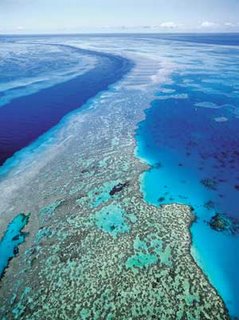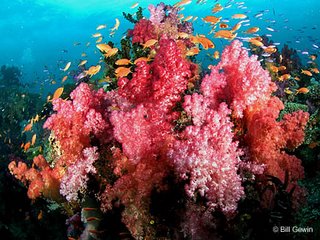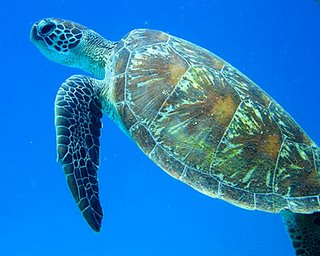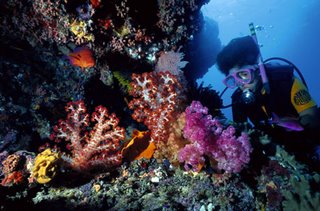 Great Barrier Reef is the world's largest coral reef ecosystem. It is often known as one of the wonders of the world. It is composed of over 2,900 individual reefs and 900 islands scattered for over 3,000 kilometres over an area of approximately 344,400 square kilometers. It consists of 3,000 coral reefs and many islets, atolls and coral cays. The Great Barrier Reef is blessed with the breathtaking beauty of the world's largest coral reef. It supports a wide diversity of life, and was selected as a World Heritage Site. The reef is a very popular tourists spot. Most of the Reef is part of the Great Barrier Reef Marine Park. It was declared as a national park. The Great Barrier Reef has a very rich biodiversity consist of important sea creatures like Whales, Dolphins, porpoises and turtles of more than six different types and also dwarf minke whale, Indo-Pacific humpback dolphin, and the humpback whale, salt water crocodile, sharks, stingrays etc. The Great Barrier Reef is a breeding area for humpback whales and is also the habitat of a few endangered species including the Dugong (Sea Cow) and large Green Sea Turtle.
Great Barrier Reef is the world's largest coral reef ecosystem. It is often known as one of the wonders of the world. It is composed of over 2,900 individual reefs and 900 islands scattered for over 3,000 kilometres over an area of approximately 344,400 square kilometers. It consists of 3,000 coral reefs and many islets, atolls and coral cays. The Great Barrier Reef is blessed with the breathtaking beauty of the world's largest coral reef. It supports a wide diversity of life, and was selected as a World Heritage Site. The reef is a very popular tourists spot. Most of the Reef is part of the Great Barrier Reef Marine Park. It was declared as a national park. The Great Barrier Reef has a very rich biodiversity consist of important sea creatures like Whales, Dolphins, porpoises and turtles of more than six different types and also dwarf minke whale, Indo-Pacific humpback dolphin, and the humpback whale, salt water crocodile, sharks, stingrays etc. The Great Barrier Reef is a breeding area for humpback whales and is also the habitat of a few endangered species including the Dugong (Sea Cow) and large Green Sea Turtle. Corals - Great Barrier Reef uniqueness comes from its three thousand coral reefs, islands, cays and lagoons, which are all at different stages of development. The reefs are the product of ten thousands years, during which the oceans rose to their present level after the last Ice Age. Small creatures known as coral polyps join together to form colonies of coral makes the reef. The coral reef can grow only in areas where there are sunlight. The most appropriate environment for coral is shallow warm water where there is a lot of water movement, where the water is salty, low in nutrients and plenty of light. Live coral is coloured by algae, but dead coral is white. Polyp looks like a jelly-like blob surrounded by a ring of tentacles on top. The busiest time in the reef is during night when the coral polyps feed, pushing out their multi-colored tentacles to entrap tiny sea creatures and plants called plankton. The reef looks like full of flowers when the billion of tentacles come out. The coral islands are home to all sorts of sea birds such as frigate birds, gannets, gulls, noddies, sea eagles, shearwaters and terns. Female turtles can be seen laying their eggs here during the summer. The sheer beauty of its fish and coral waterscapes draws two million tourists annually who come to see the underwater spectacle via diving, snorkeling and glass-bottom boating.
Corals - Great Barrier Reef uniqueness comes from its three thousand coral reefs, islands, cays and lagoons, which are all at different stages of development. The reefs are the product of ten thousands years, during which the oceans rose to their present level after the last Ice Age. Small creatures known as coral polyps join together to form colonies of coral makes the reef. The coral reef can grow only in areas where there are sunlight. The most appropriate environment for coral is shallow warm water where there is a lot of water movement, where the water is salty, low in nutrients and plenty of light. Live coral is coloured by algae, but dead coral is white. Polyp looks like a jelly-like blob surrounded by a ring of tentacles on top. The busiest time in the reef is during night when the coral polyps feed, pushing out their multi-colored tentacles to entrap tiny sea creatures and plants called plankton. The reef looks like full of flowers when the billion of tentacles come out. The coral islands are home to all sorts of sea birds such as frigate birds, gannets, gulls, noddies, sea eagles, shearwaters and terns. Female turtles can be seen laying their eggs here during the summer. The sheer beauty of its fish and coral waterscapes draws two million tourists annually who come to see the underwater spectacle via diving, snorkeling and glass-bottom boating. Sea Creatures - 17 species of sea snake live on the Great Barrier Reef. More than 1,500 species of fish live on the reef, including the red-throat emperor, red bass, clownfish, and several species of snapper and coral trout. Six species of sea turtles come to the reef to breed – the green sea turtle, hawksbill turtle, loggerhead sea turtle, leatherback sea turtle,olive ridley and the flatback turtle. A large group of dugongs live here. In mangrove and saltmarshes near the reef Salt water crocodiles lived.
Sea Creatures - 17 species of sea snake live on the Great Barrier Reef. More than 1,500 species of fish live on the reef, including the red-throat emperor, red bass, clownfish, and several species of snapper and coral trout. Six species of sea turtles come to the reef to breed – the green sea turtle, hawksbill turtle, loggerhead sea turtle, leatherback sea turtle,olive ridley and the flatback turtle. A large group of dugongs live here. In mangrove and saltmarshes near the reef Salt water crocodiles lived. Scuba Diving - This spectacular area has also become one of the top scuba diving sites in the world. There are 16 exclusive dive sites on 4 spectacular outer reefs. These are Thetford, Pellowe, Milln and Flynn. The dive sites have an average depth ranging from approximately 30 to 80 feet. Scuba Diving is most refreshing, entertaining and thrilling. Its tropical climatic conditions makes it popular for Scuba Diving. The sea is calm, throughout the year. Due to which this place has acquired for the activity of scuba diving.
Scuba Diving - This spectacular area has also become one of the top scuba diving sites in the world. There are 16 exclusive dive sites on 4 spectacular outer reefs. These are Thetford, Pellowe, Milln and Flynn. The dive sites have an average depth ranging from approximately 30 to 80 feet. Scuba Diving is most refreshing, entertaining and thrilling. Its tropical climatic conditions makes it popular for Scuba Diving. The sea is calm, throughout the year. Due to which this place has acquired for the activity of scuba diving.Exploring the Great Barrier Reef is exciting, safe and easy. You can snorkel or scuba dive on boat trips with experienced crew on hand to supervise.Because of its natural beauty, both below and above the water's surface, the Great Barrier Reef has become one of the worlds most sought tourist destinations.